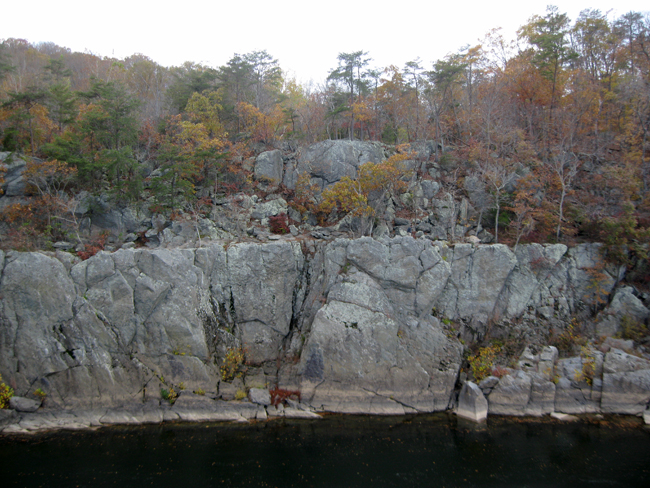8 December 2014
Fluvial geomorphology of Mather Gorge
Posted by Callan Bentley
Mather Gorge is the name given to the narrow, deeply incised section of the Potomac River Gorge downstream from Great Falls. It’s named for Stephen Mather, the first superintendent of the U.S. National Park Service. It’s very straight, probably because it’s etched out along the trace of a fault. You can get a sense of the linear nature of Mather Gorge with this photo (paddle-boarding human for scale):

The Gorge is a nested series of bedrock terraces or straths. Looking across Mather Gorge, these flat “steps” are obvious features to the landscape. Here, you see the Matildaville strath (upper, older) and the Bear Island strath (lower, younger). Each of these levels used to be the bottom of the Potomac River, prior to incision to deeper, newer levels.

As you walk along the Bear Island strath (on the Billy Goat Trail, say), you encounter a great many features that indicate you’re walking on the abandoned bottom of the Potomac River. Exotic boulders (paleo-bedload, sourced to the Blue Ridge and Culpeper Basin, sites upstream of the Billy Goat Trail) are one such signature of the strath’s former incarnation, and so are the numerous potholes, each of which was drilled into the solid rock by a sustained vortex of sediment-laden river water:

I love taking students to the Billy Goat Trail primarily for the stunning story woven into the bedrock geology, but these landforms are a welcome set of bonus features: easy on the eyes and enlightening for the mind.


 Callan Bentley is Associate Professor of Geology at Piedmont Virginia Community College in Charlottesville, Virginia. He is a Fellow of the Geological Society of America. For his work on this blog, the National Association of Geoscience Teachers recognized him with the James Shea Award. He has also won the Outstanding Faculty Award from the State Council on Higher Education in Virginia, and the Biggs Award for Excellence in Geoscience Teaching from the Geoscience Education Division of the Geological Society of America. In previous years, Callan served as a contributing editor at EARTH magazine, President of the Geological Society of Washington and President the Geo2YC division of NAGT.
Callan Bentley is Associate Professor of Geology at Piedmont Virginia Community College in Charlottesville, Virginia. He is a Fellow of the Geological Society of America. For his work on this blog, the National Association of Geoscience Teachers recognized him with the James Shea Award. He has also won the Outstanding Faculty Award from the State Council on Higher Education in Virginia, and the Biggs Award for Excellence in Geoscience Teaching from the Geoscience Education Division of the Geological Society of America. In previous years, Callan served as a contributing editor at EARTH magazine, President of the Geological Society of Washington and President the Geo2YC division of NAGT.
What, I wonder, would induce the incision to the next strath?
Base level drop. Bierman, et al. (2004) ascribe it to Ice Age sea level drop coupled with widespread permafrost leading to increased runoff. http://pubs.usgs.gov/circ/2004/1264/html/trip6/index.html
It’s the “mantle bulge” causing the uplift… delamination… displacement due to flat slab subduction of the Farallon plate… it’s the mantle bulge at work…